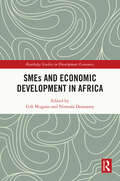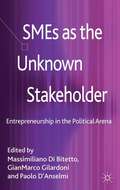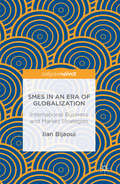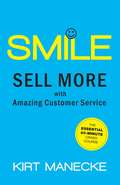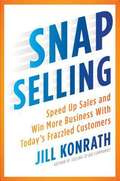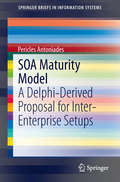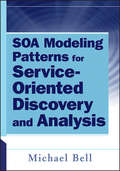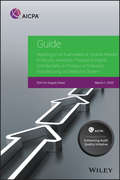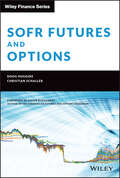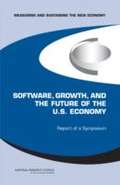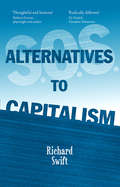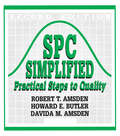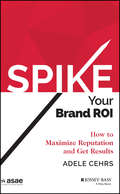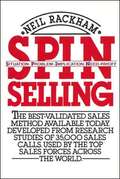- Table View
- List View
SMEs and Economic Development in Africa (Routledge Studies in Development Economics)
by Nirmala Dorasamy Gift MuganoSmall and medium-sized enterprises (SMEs) are a driving force of the global economy, contributing up to 50% of gross domestic product in some instances. They also contribute to economic development through various channels such as employment creation, economic growth and poverty reduction, key elements of the Sustainable Development Goals. Furthermore, in many economies the majority of jobs are provided by SMEs. However, despite their support of the economy, SMEs are prone to several binding constraints, such as access to finance and market entry, as well as exogenous shocks and crises, most recently the COVID-19 pandemic. Building on evidence from international experience, SMEs and Economic Development in Africa provides grounded solutions to challenges affecting SMEs, particularly in Africa, and offers guidance on how to build resilience to counteract future shocks. It also offers a number of policy measures which governments in developing countries may need to consider in order to encourage economic growth and development, such as increasing productive capacities, training, enhancing business ethics and professionalism and improving competitiveness. What makes this book distinctive is that fact that it brings together the literature concerning SMEs in one place, and using case studies, it showcases how policymakers can overcome the challenges affecting SMEs. The book also provides tested and practical remedies for African economies with a view to making SMEs a springboard for economic prosperity. The book will appeal to advanced students, scholars and researchers, as well as policymakers, development agencies and non-governmental organisations.
SMEs as the Unknown Stakeholder
by Massimiliano Di BitettoInvestigates how and to what extent the self-employed and micro-enterprise workers can be represented in the social arena. A cross-sector approach to responsibility for government as well as private businesses.
SMEs in Asian Developing Countries
by Tulus Tahi Hamonangan TambunanAnalyzing the development of small and medium enterprises (SMEs) in Asian developing countries, the book is based on a survey of key literature and data on SMEs with the focus on; recent development, export performance, main constraints, competitiveness, innovation and technology transfer, and female entrepreneurs.
SMEs in an Era of Globalization
by Ilan BijaouiThis book identifies the driving forces behind globalization and proposes innovative ways for small and medium-enterprises (SMEs) to confront them. More than ever, sustainable competitive advantage requires SMEs to continually adapt their strategy and confront new and current competition in the international market. SMEs working with multinational companies could also benefit from winning strategies based on a sensible analysis of rational and irrational phenomena at the micro- and macro-economic levels. This book uses different models developed and established through international business experiences to determine the relevant strategy in the global market. It illustrates each model through real, successful case studies of globalization of factor, efficiency, and innovation-driven SMEs. It will benefit scholars of entrepreneurship, international business, regional development as well as managers, governmental institutions, and regional development, and consultants to SMEs.
SMILE - Übungs- und Lösungsbuch zum Kompaktband Logistik (Schule für Mathematik, Informatik, Logistik und Erfolg)
by Sven WirsingDieses Übungsbuch ergänzt den SMILE-Kompaktband mit einer Vielzahl von Übungsaufgaben und deren Lösungen. Alle im Kompaktband dargestellten Inhalte: Grundlagen, Wareneingangskontrolle, Chargenschnittstelle, Kühlguteinlagerung, GUI-Dialoge und Disposition von LKWs werden mit logistischen und mathematischen Aufgaben sowie Fragestellungen zu Python vertieft. Die Python-Lösungen sind bei Springer downloadbar. Ein besonderes Highlight ist das letzte Kapitel Szenario „Tischtennis-AG“, in dem mittels einer fiktiven Firma, die Tischtennis-AG, die wichtigsten Thematiken zu allen Kapiteln erneut als Aufgaben praxisrelevant dargestellt werden.
SMILE: Sell More With Amazing Customer Service
by Kirt Manecke<p>Does your customer service team hurt your business? Are you losing money as a result? Poor customer service costs U.S. businesses approximately $83 billion annually. It’s time to get that money back with excellent training anyone on your staff can learn in just 60 minutes or less. <p>Smile: Sell More with Amazing Customer Service is a quick, easy, unique and powerful training program packed with actionable tips, systems, and strategies. Bestselling author Kirt Manecke’s award-winning manual can transform your staff into superior customer service and sales professionals no matter what their skill level or experience. And here’s the best part: Smile is so easy to implement, you can get started on the training right away!</p>
SNAP Selling
by Jill KonrathSelling is tougher than ever before. Potential customers are under extreme pressure to do more with less money, less time, and fewer resources, and they're wary of anyone who tries to get them to buy or change anything. Under such extreme conditions, yesterday's sales strategies no longer work. No matter how great your offering, you face the daunting task of making yourself appear credible, relevant, and valuable. Now, internationally recognized sales strategist Jill Konrath shows how to overcome these obstacles to get more appointments, speed up decisions, and win sales with these short-fused, frazzled customers. Drawing on her years of selling experience, as well as the stories of other successful sellers, she offers four SNAP Rules: -Keep it Simple: When you make things easy and clear for your customers, they'll change from the status quo. -Be iNvaluable: You have to stand out by being the person your customers can't live without. -Always Align: To be relevant, make sure you're in synch with your customers' objectives, issues, and needs. -Raise Priorities: To maintain momentum, keep the most important decisions at the forefront of their mind. SNAP Sellingis an easy-to-read, easy-to-use guide for any seller in today's increasingly frenzied environment.
SOA Maturity Model
by Pericles AntoniadesCompanies have long sought to integrate existing Information Systems (IS) in order to support existing and potentially new business processes spread throughout their "territories" and possibly to collaborating organizations. A variety of designs can be used to this end, ranging from rigid point-to-point electronic data interchange (EDI) interactions to "Web auctions". By updating older technologies, such as "Internet-enabling" EDI-based systems, companies can make their IT systems available to internal or external customers; but the resulting systems have not proven to be flexible enough to meet business demands. A more flexible, standardized architecture is required to better support the connection of various applications and the sharing of data. Service-Oriented Architecture (SOA) is one such architecture. It unifies ("orchestrates") business processes by structuring large applications as an ad-hoc collection of smaller modules called "Services". These applications can be used by different groups of people both inside and outside the company, and new applications built from a mix of services (located in a global repository) exhibit greater agility and uniformity. Thus, SOA is a design framework for realizing rapid and low-cost system development and improving total system quality. SOA uses the Web Services standards and technologies and is rapidly becoming a standard approach for enterprise information systems integration. SOA adoption by enterprises has been identified as one of the highest business priorities by a recent Gartner study (Gartner 2007) and enterprises increasingly recognize the requirement for an increased "Service-orientation" and relevant comprehensive frameworks, which will not only help them position themselves and evaluate their SOA initiatives, but also guide them in achieving higher levels of SOA maturity. This in turn, will help enterprises acquire (and retain) competitive advantage over other players in the market who are not (using SOA and thus they are not) so flexibly adjusting themselves to address new business requirements. This book proposes a new SOA Maturity Model (MM) using a Delphi-variant technique and this constitutes one of its distinguishing features because none of the relevant existing works utilized Delphi. Moreover, the fact that the proposed SOA MM supports inter-enterprise setups makes it even more distinct. The newly proposed SOA MM is then used to help the participating organizations position themselves in respect to SOA (current status), guide them to achieve higher levels of SOA maturity, and anticipate their SOA maturity in five years' time. Furthermore, the "local" or "global" nature of the proposed SOA MM is investigated. This is checked firstly against selected expert panel participants and secondly against local business practitioners.
SOA Modeling Patterns for Service Oriented Discovery and Analysis
by Michael BellLearn the essential tools for developing a sound service-oriented architectureSOA Modeling Patterns for Service-Oriented Discovery and Analysis introduces a universal, easy-to-use, and nimble SOA modeling language to facilitate the service identification and examination life cycle stage. This business and technological vocabulary will benefit your service development endeavors and foster organizational software asset reuse and consolidation, and reduction of expenditure.Whether you are a developer, business architect, technical architect, modeler, business analyst, team leader, or manager, this essential guide-introducing an elaborate set of more than 100 patterns and anti-patterns-will help you successfully discover and analyze services, and model a superior solution for your project,. Explores how to discover servicesExplains how to analyze services for construction and productionHow to assess service feasibility for deploymentHow to employ the SOA modeling language during the service identification and examination processHow to utilize the SOA modeling patterns and anti-patterns for service discovery and analysisFocusing on the Service-Oriented Discovery and Analysis Life Cycle Stage, this book will help you acquire a broad SOA Modeling knowledge base and leverage that to increase efficiency and productivity in the workplace.
SOC for Supply Chain: Reporting on an Examination of Controls Relevant to Security, Availability, Processing Integrity, Confidentiality, or Privacy in a Production, Manufacturing, or Distribution System, 2020 (AICPA)
by AICPAInternal and external forces such as globalization, global interconnectivity, automation, and other technological advancements are making today’s supply chains highly sophisticated and complex. For organizations that produce, manufacture or distribute products, there’s often a high level of interdependence and connectivity with their suppliers and their customers and business partners. Although the interconnectedness of these organizations can be beneficial (increased revenues, expanded market opportunities, and cost reduction), the ability of organizations to meet their goals is often increasingly dependent on events, processes, and controls that are not visible and are often beyond their control – such as a supplier’s controls. That’s why the demand for transparency in supply chains is now higher than ever before, and why this is the perfect time for you to help organizations assess their supply chain risks, evaluate the system controls within their manufacturing, production, or distribution systems, and communicate their supply chain management efforts to those with whom they do business. Accountants and financial managers can also increase the credibility of the supply chain information communicated by the organization by providing an opinion on the organization’s supply chain efforts. This guide enables the accountant and financial manager to examine and report on the description of a system for manufacturing, producing and distributing goods as well as on the controls within that system using a dynamic, proactive, and agile approach. It will show how to conduct this examination in accordance with the attestation standards. The guide may also be helpful when providing readiness assessments to clients, who are not quite ready for an examination level service and need help to get there. The guide also includes excerpts from the two distinct, but complementary sets of criteria developed by the AICPA to assist practitioners with SOC for Supply Chain engagements: the description criteria and the 2017 trust services criteria.
SOCIAL RIGHTS IN EUROPE IN AN AGE OF AUSTERITY (Critical Studies in Jurisprudence)
by Simon Halliday Stefano Civitarese MatteucciThis collection of essays examines the promise and limits of social rights in Europe in a time of austerity. Presenting in the first instance five national case studies, representing the biggest European economies (UK, France, Germany, Italy and Spain), it offers an account of recent reforms to social welfare and the attempts to resist them through litigation. The case studies are then used as a foundation for theory-building about social rights. This second group of chapters develops theory along two complementary lines: first, they explore the dynamics between social rights, public law, poverty and welfare in times of economic crisis; second, they consider the particular significance of the European context for articulations of, and struggles over, social rights. Employing a range and depth of expertise across Europe, the book constitutes a timely and highly significant contribution to socio-legal scholarship about the character and resilience of social rights in our national and regional constitutional settings.
SOFR Futures and Options (Wiley Finance)
by Christian Schaller Doug HugginsSOFR Futures and Options is the practical guide through the maze of the transition from LIBOR. In the first section, it provides an in-depth explanation of the concepts involved: The repo market and the construction of SOFR SOFR-based lending markets and the term rate The secured-unsecured basis SOFR futures and options and their spread contracts Margin and convexityApplying these insights, the second section offers detailed worked-through examples of hedging loans, swaps, bonds, and floors with SOFR futures and options, supported by interactive spreadsheets accessible on the web. The gold standard resource for professionals working at financial institutions, SOFR Futures and Options also belongs in the libraries of students of finance and business, as well as those preparing for the Chartered Financial Analyst exam.
SOFTWARE, GROWTH, AND THE FUTURE OF THE U.S. ECONOMY: Report of a Symposium
by National Research Council of the National AcademiesStarting in the mid 1990s, the United States economy experienced an unprecedented upsurge in economic productivity. Rapid technological change in communications, computing, and information management continue to promise further gains in productivity, a phenomenon often referred to as the New Economy. To better understand this phenomenon, the National Academies Board on Science, Technology, and Economic Policy (STEP) has convened a series of workshops and commissioned papers on Measuring and Sustaining the New Economy. This major workshop, entitled Software, Growth, and the Future of the U.S. Economy, convened academic experts and industry representatives from leading companies such as Google and General Motors to participate in a high-level discussion of the role of software and its importance to U.S. productivity growth; how software is made and why it is unique; the measurement of software in national and business accounts; the implications of the movement of the U.S. software industry offshore; and related policy issues.
SOFWERX: Innovation at U.S. Special Operations Command (Abridged)
by Herman B. Leonard Kerry Herman Mitchell B. Weiss Jin Hyun PaikJames "Hondo" Geurts, the Acquisition Executive for U.S. Special Operations Command was in the middle of his Senate confirmation hearing in 2017 to become Assistant Secretary of the Navy for Research, Development and Acquisition. The questions had a common theme: how would Geurts's experience running an innovative procurement effort for U.S. Special Forces units enable him to change a much larger-and much more rigid-organization like the U.S. Navy? In one of the most secretive parts of the U.S. military, Geurts founded an open platform called SOFWERX to speed the rate of ideas to Navy SEALs, Army Special Forces, and the like. His team even sourced the idea for a hoverboard from a YouTube video. But how should things like SOFWERX and protypes like the EZ-Fly find a place within the Navy writ large?
SOHO China: Design, Development, and Social Harmony
by Arthur I Segel Mukti KhaireFounded in 1995 by Zhang Xin and her husband Mr. Pan Shiyi, SOHO China has developed into a world-class real estate development firm that has consistently delivered high-quality projects known for their cutting-edge designs and investment potential. Despite the tremendous success of the firm, Zhang Xin still looks at the future with great uncertainty. Average residential pricing in China has dropped, as government continues to put downward pressure on residential housing prices through restrictions on the number of apartments a resident is allowed to purchase, and aggressive promotion of affordable housing on the low-end of the market. Zhang Xin wonders what opportunities and threats such market conditions present to SOHO. On the sales and marketing front, SOHO China has historically been geographically-focused only on high-end, design-driven projects in Shanghai and Beijing. As the market became more competitive, Zhang Xin wondered what key strategic decisions in regards to design, financing, and sales the company would need to make in order to maintain its competitive advantage in China.
SOHO China: Transformation in Progress
by Charles F WuIn 2016 against the backdrop of a challenging Chinese macroeconomic environment, SOHO China, the largest owner and developer of Class-A real estate in Beijing and Shanghai, was struggling to convince analysts of the merits of their new "build-to-hold" strategy. Founded as a merchant builder, the company went public in 2007 raising a record USD 1.9 billion, but the firm, led by Zhang Xin, refocused in 2012 towards a "build-to-hold" strategy in an effort to capture the long-term value of their properties. Ms. Zhang also saw an opportunity to capitalize on the rapidly growing "shared office" trend developing their own '3Q' coworking product placing these centers in their newly held buildings. Despite 3Q's initial success and the "build-to-hold" strategy beginning to bear fruit, SOHO's stock price was still near record lows. How could Zhang Xin educate the stock market to reward SOHO's share price and acknowledge the successful transition? Would these strategic decisions be sufficient to steer SOHO China through new economic hurdles? Is 3Q enough to buoy SOHO's performance and bring them into the next phase of growth?
SOS Group: Scaling a Social Enterprise Conglomerate
by Vincent Dessain Jerome Lenhardt Julie Battilana"Jean-Marc Borello, founder and chairman of SOS Group, the largest social enterprise group in France, was preparing to meet with the rest of the executive board to discuss strategy. He recalled all the work done since the inception of SOS Group in 1984, when the organization focused on helping drug users with AIDS cope with the disease. Over the years, SOS Group had expanded its activities across five different sectors: health, employment, solidarity, youth, and seniors. In doing so, the group had grown substantially, acquiring over 100 organizations, 95% of which were not-for-profit, and by the end of 2015, reported revenuesa of 699 million euros (hereafter €), employed 13,000 people, and had served over 1.5 million beneficiaries since inception, according to SOS Group’s estimations (see Exhibit 1 for SOS Group main indicators from 2008 to 2015).b As SOS Group grew and diversified, Borello felt, “The group had successfully maintained its core set of values and principles: constant innovation to meet new needs, constant re-assessment of organizational processes, nimbleness, and social impact as the overarching goal of the organization.”
SOS: Alternatives to Capitalism
by Richard SwiftFinancial collapse and crisis; disgust at bankers’ greed; the devastating effects of yawning inequality: all these and more have led to widespread dissatisfaction and disenchantment with capitalism. People are crying out for an alternative but are continually told that one does not exist. In this fully updated new edition Richard Swift examines the past shortcomings and present health of not one but many other paths to changing the world, including socialism, social democracy, anarchism, ecology, and degrowth. Combining the practical with the visionary, he shows that finding alternatives to capitalism is no longer an academic issue for the left – it is an urgent planetary necessity.
SPA - Screening psychischer Arbeitsbelastung: Manual (SpringerTests)
by Anna-Marie Metz Heinz-Jürgen RotheArbeitsbedingte psychische Erkrankungen sind in den letzten 10 Jahren zu den häufigsten Ursachen für Fehlzeiten und Erwerbsminderungsrenten geworden. Im Mittelpunkt des Buches stehen die detaillierte Beschreibung eines psychologischen Verfahrens zur qualitätsgesicherten, effizienten und praktikablen Analyse und Beurteilung psychischer Belastungsfaktoren in Arbeitsprozessen. Aus den Ergebnissen werden Hinweise für bedingungs- und personenbezogene gesundheitsförderliche Maßnahmen abgeleitet. Das Instrument hat sich bei Gefährdungsbeurteilungen in Unternehmen aller Größen und Branchen bewährt, es ermöglicht, Schwachstellen in der Gestaltung von Arbeitssituationen zu identifizieren sowie komplexe Beziehungen zwischen Arbeitsinhalt, Arbeitsbedingungen und deren Folgen wissenschaftlich aufzuklären.
SPAC Space
by John R. Wells Benjamin Weinstock"In 2020, over half of all initial public offerings (IPOs) in the United States were special purpose acquisition companies (SPACs), blank-check companies that typically had two years to find a business to take public, usually through a reverse merger. Together, 248 SPACs raised over $83 billion, 46% of the total US IPO proceeds in 2020. The SPAC boom accelerated in 2021. By the end of March 2021, there were 298 SPAC IPOs year-to-date, raising $96.6 billion. At the time, SPAC sponsors were eagerly seeking out opportunities in sectors such as fintech, healthtech, renewable energy, and electric vehicles to invest the $136 billion they had at their disposal. Moreover, there was another $66.4 billion in SPAC IPOs in the pipeline. The opportunities for SPAC sponsors were attractive, as much as a ten-times return on their investment, but SPAC investors had also made some spectacular returns. For instance, Luminar Technologies, a leading producer of sensor technology for autonomous vehicles, entered into a definitive agreement with a SPAC in August 2020, for a post money valuation of $3.4 billion. At the end of March 2021, it was valued at $8.3 billion, down from a day-end high of $13.5 billion, but still up 135% on flotation. Proponents of SPACs touted a more efficient and streamlined path to public markets compared to the traditional IPO process - a type of "regulatory arbitrage." There was also the benefit of giving retail investors opportunities that would be otherwise reserved for private equity and institutional investors. Yet many industry observers were skeptical of the SPAC boom, noting the misalignment between sponsor and shareholder interests, the opacity of the process, and the poor historic returns of the entire asset class. They believed that the SPAC boom would soon end.
SPC Simplified: Practical Steps to Quality
by Robert T AmsdenWritten in clear language, this hands-on manual simplifies the essentials for monitoring, analyzing, and improving quality. While the authors employ statistical tools, these are rooted in practical examples, which require only basic math skills. The book explains how to set up and use variable and attribute control charts, as well as analyze freque
SPECIALISTERNE: Sense and Details
by Robert D. Austin Jonathan Wareham Javier BusquetsThree-quarters of Specialisterne's expert software testing staff are diagnosed with some form of Autistic Spectrum Disorder (ASD). Usually a handicap, ASD conveys talents especially suited to software testing and other highly repetitive tasks that require very high accuracy. This case describes a growing company struggling with unique challenges as it implements a "social enterprise" business model; it describes the difficulties faced by social entrepreneurs implementing for-profit business models in domains usually populated by non-profits. The case is also useful as an introduction to the business of software testing.
SPIKE your Brand ROI
by Adele R. CehrsIncrease ROI through more effective brand marketing According to CMO.com, we are exposed to more than 5,000 brandmessages each day. Marketers call this "creating engagement,"and each comment, share, or re-tweet is supposed to be a win. Butis this deluge of content really working to shift perception,change behavior, or sell products? The truth is, only 5% ofpeople say that social media has a profound effect on theirpurchasing decisions. Moreover, only 2.7% of people are willing tostick their neck out on the line to recommend your brand via socialmedia, a factor known as "social risk."In SPIKE Your Brand ROI, public relations maven AdeleCehrs shares her strategy for effective engagement: it's allabout timing. This book will teach you how to recognize,anticipate, or even create a SPIKE - a Sudden Point ofInterest that Kick-starts Exposure. This is your opportunity toreach people when they are primed to hear your message, and yourbrand is most relevant to their lives.Based on the author's actual engagements with clients likeYum Brands, Lockheed Martin, DuPont, and more, this practical guideoutlines a new, pragmatic approach that will enable youto: Learn to recognize brand patterns that are driven by audienceinterests and outside eventsFocus your energy, resources, and money when your brand istop-of-mindDecrease your marketing spend while increasing your bottom-linebenefitsMaximize benefits or mitigate damage by anticipating when yourcompany, association, or nonprofit is going to be in thespotlightRetool traditional word-of-mouth initiatives for optimumresultsWith Adele Cehrs' proven methodology, you can turn a SPIKE intoa strategic platform from which to improve results, build respect,and boost your ROI.
SPIN Selling
by Neil RackhamIt's about the larger sale. Almost all existing books on selling have used models and methods that were developed in low-value, one-call sales
